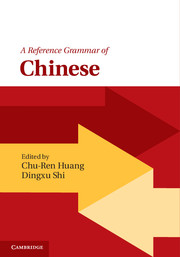Book contents
- Frontmatter
- Dedication
- Contents
- List of figures
- List of tables
- List of contributors
- Preface
- Acknowledgements
- English–Chinese term list
- Chinese–English term list
- 1 Preliminaries
- 2 Syntactic overview
- 3 Lexical word formation
- 4 Verbs and verb phrases
- 5 Aspectual system
- 6 Negation
- 7 Classifiers
- 8 Nouns and nominal phrases
- 9 Relative constructions
- 10 Adjectives and adjective phrases
- 11 Comparison
- 12 Adverbs
- 13 Prepositions and preposition phrases
- 14 Sentence types
- 15 Major non-canonical clause types: ba and bei
- 16 Deixis and anaphora
- 17 Information structure
- Appendix: Punctuation
- Bibliography
- Index
Appendix: Punctuation
Published online by Cambridge University Press: 05 March 2016
- Frontmatter
- Dedication
- Contents
- List of figures
- List of tables
- List of contributors
- Preface
- Acknowledgements
- English–Chinese term list
- Chinese–English term list
- 1 Preliminaries
- 2 Syntactic overview
- 3 Lexical word formation
- 4 Verbs and verb phrases
- 5 Aspectual system
- 6 Negation
- 7 Classifiers
- 8 Nouns and nominal phrases
- 9 Relative constructions
- 10 Adjectives and adjective phrases
- 11 Comparison
- 12 Adverbs
- 13 Prepositions and preposition phrases
- 14 Sentence types
- 15 Major non-canonical clause types: ba and bei
- 16 Deixis and anaphora
- 17 Information structure
- Appendix: Punctuation
- Bibliography
- Index
Summary
Punctuation, strictly speaking, is part of the orthography and not a proper component of the grammar. In reading and writing, however, punctuation marks bring out the subtlety in grammar which is often inadequately expressed by textual representation. In this sense, punctuation is not unlike prosody in speech: something that is needed for understanding and has to be considered in conjunction with the perceived phonemic units. Punctuation is a relatively new innovation in Chinese writing. Traditional Chinese printed texts did not have punctuation and until the early twentieth century, readers of Chinese texts were required to break down the text into different units, as mentioned in Chapter 1. Punctuation marks are now an integral part of written Chinese. They are symbols to indicate pauses, the nature and function of certain expressions, and the structure and organization of sentences.
There are seventeen types of punctuation marks in written Chinese: period, question mark, exclamation mark, comma, caesura mark, semicolon, colon, quotation marks, emphasis marks, parentheses, dash, ellipsis points, connection mark, interval mark, separation mark (slash), book title mark, and proper noun mark. They can be classified into two major categories:
1 Punctuation marks that indicate boundaries, which are divided into three subcategories:
(a) markers of major (usually sentential) boundaries: period, question mark, and exclamation mark;
(b) markers of secondary boundaries between expressions or clauses: comma and caesura mark; and
(c) markers of boundary and relationship between two expressions: colon and semicolon.
2 Punctuation marks that indicate the nature and function of expressions, which are divided into five subcategories:
(a) markers to enclose a quotation or to indicate emphasis: quotation marks and emphasis marks;
(b) markers to indicate amendment or explanation: parentheses and dash;
(c) markers to indicate omission: ellipsis points;
(d) markers to indicate the relation between words: hyphen, interval mark, and slash mark; and
(e) markers to indicate the nature of certain expressions: book title mark and proper noun mark.
Boundary-marking punctuation marks
As mentioned above, there are three subtypes of boundary-marking punctuation marks.
Marks marking major boundaries
Period
A period “。” is a small circle at the bottom part of the line. It is different in appearance from the Western period “.” but has similar functions.
- Type
- Chapter
- Information
- A Reference Grammar of Chinese , pp. 577 - 590Publisher: Cambridge University PressPrint publication year: 2016

